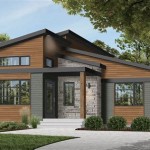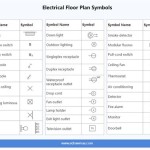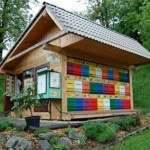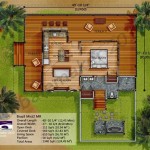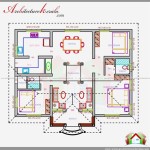Small Straw Bale House Plans: A Comprehensive Guide
Straw bale construction, an age-old technique experiencing a modern resurgence, offers a sustainable and cost-effective alternative to conventional building methods. Small straw bale houses, in particular, are gaining popularity as individuals and families seek eco-friendly, energy-efficient, and affordable housing options. This article delves into the intricacies of small straw bale house plans, exploring the key considerations, benefits, and construction details involved in bringing such a project to fruition.
Understanding the fundamental principles of straw bale construction is paramount before embarking on the design and planning phase. Straw bales, primarily sourced from agricultural byproducts such as wheat, rice, or barley, provide excellent insulation due to their high R-value. This inherent thermal performance translates to significant energy savings for heating and cooling, making straw bale homes exceptionally energy-efficient. Furthermore, straw is a readily available and renewable resource, contributing to a reduced carbon footprint compared to conventional building materials like concrete and steel.
Small straw bale houses often range in size from tiny homes under 500 square feet to small cottages and cabins up to 1,200 square feet. These smaller footprints make straw bale construction more accessible and manageable, reducing both material costs and construction time. The design possibilities are virtually limitless, allowing for a wide range of architectural styles, from rustic and traditional to modern and contemporary.
Key Point 1: Design Considerations for Small Straw Bale Houses
The design of a small straw bale house requires careful consideration of several factors, including site selection, building codes, bale specifications, and structural requirements. The chosen site should be well-drained to prevent moisture damage to the straw bales. Proper orientation to maximize solar gain in colder climates and minimize heat gain in warmer climates is also crucial for optimizing energy efficiency.
Local building codes and regulations must be thoroughly researched and adhered to. While straw bale construction is becoming increasingly recognized and accepted, some jurisdictions may have specific requirements or restrictions. Obtaining the necessary permits and approvals is essential to avoid legal complications and ensure the structural integrity and safety of the building.
Selecting the appropriate type and size of straw bales is critical for successful construction. Bales should be dry, dense, and uniform in size and shape to ensure consistent insulation and structural stability. The moisture content of the bales should be carefully monitored to prevent mold growth and decay. The dimensions of the bales will dictate the wall thickness and overall dimensions of the house, influencing the design and layout.
Two primary structural systems are commonly used in straw bale construction: load-bearing and non-load-bearing. Load-bearing straw bale walls support the weight of the roof and upper floors, eliminating the need for a separate frame. This method requires careful engineering and precise bale placement to ensure structural integrity. Non-load-bearing straw bale walls, on the other hand, are used as infill within a timber or steel frame, providing insulation and a durable exterior finish. This method offers greater flexibility in design and allows for larger windows and openings.
The design should also incorporate passive solar design principles to maximize natural light and ventilation. Strategically placed windows and skylights can reduce the reliance on artificial lighting and heating, further enhancing energy efficiency. Overhangs and shading devices can prevent excessive heat gain during the summer months.
Key Point 2: Construction Techniques and Materials
The construction of a small straw bale house involves several key steps, including foundation preparation, bale stacking, plastering, and finishing. A solid and well-drained foundation is essential to prevent moisture from wicking up into the straw bales. Concrete slabs, rubble trench foundations, or pier foundations are commonly used, depending on the site conditions and local building codes.
Bale stacking is a critical process that requires careful attention to detail. The bales are typically stacked like bricks, overlapping each other to create a stable and interlocking wall system. Specialized tools, such as bale forks and bale string needles, are used to handle and secure the bales. Compression is often applied during stacking to ensure a tight and uniform wall surface.
Plastering protects the straw bales from moisture, fire, and insect infestation. Natural plasters, such as clay, lime, or earth plasters, are commonly used due to their breathability and low environmental impact. These plasters allow moisture to escape from the bales, preventing mold growth and decay. Multiple coats of plaster are typically applied to create a durable and weatherproof finish.
The choice of roofing materials is also crucial for the overall performance of the house. Metal roofs, tile roofs, and green roofs are popular options that offer durability, longevity, and aesthetic appeal. Proper insulation and ventilation in the roof assembly are essential to prevent condensation and maintain a comfortable indoor climate.
Interior finishes can be customized to suit individual preferences. Natural materials, such as wood, bamboo, and reclaimed materials, are often used to complement the sustainable nature of the straw bale construction. Low-VOC paints and finishes are recommended to minimize indoor air pollution.
Key Point 3: Benefits and Challenges of Small Straw Bale Houses
Small straw bale houses offer numerous benefits, including energy efficiency, sustainability, affordability, and aesthetic appeal. The excellent insulation properties of straw bales significantly reduce heating and cooling costs, resulting in substantial energy savings over the lifespan of the house. Straw is a renewable and readily available resource, making straw bale construction a sustainable and environmentally friendly building option.
Compared to conventional building methods, straw bale construction can be more affordable, particularly when utilizing local materials and labor. The reduced energy consumption further contributes to long-term cost savings. The thick walls of straw bale houses provide excellent sound insulation, creating a quiet and peaceful living environment.
The natural and organic appearance of straw bale walls adds a unique aesthetic appeal to the house. The rounded corners and textured surfaces create a warm and inviting atmosphere. Straw bale construction allows for creative design possibilities and the incorporation of natural building techniques.
However, straw bale construction also presents certain challenges that must be addressed. Moisture management is crucial to prevent mold growth and decay. Proper detailing and construction techniques are essential to ensure the long-term durability and performance of the house. Securing financing and insurance for straw bale houses can be more challenging than for conventional construction, as some lenders and insurers may be unfamiliar with this building method.
Finding experienced and qualified builders and contractors who are knowledgeable in straw bale construction can also be a challenge, particularly in areas where this building method is not widely practiced. Thorough planning and research are essential to overcome these challenges and ensure a successful straw bale construction project.
The labor-intensive nature of straw bale construction requires a significant investment of time and effort. However, many homeowners find the process rewarding and enjoy the opportunity to actively participate in the construction of their own home. Building workshops and hands-on training programs can provide valuable skills and knowledge for those interested in learning more about straw bale construction.
Ultimately, small straw bale house plans offer a promising alternative to conventional housing, providing a sustainable, energy-efficient, and aesthetically pleasing living environment. By carefully considering the design considerations, construction techniques, and potential challenges, individuals and families can realize their dream of owning a unique and environmentally friendly straw bale home.

Plans For Organicforms Design

Free Open Source Strawbale House Design Natural Building Blog

Straw Bale House Plans Small 4 Bedroom W Unique Features

Straw Bale House Plans For A Country Style 3 Bedroom Home

Pin On Straw Bale House Loft Railing Via

Straw Bale House Plan From Balewatch Com Tiny Plans

24 X 36 Straw Bale House Plan W Loft Heirloom Builders Inc

Plans For A Small Starter Straw Bale Home Or Guest House

Straw Bale House Floor Plan Small Plans

Timber Frame Straw Bale House Design The Year Of Mud


